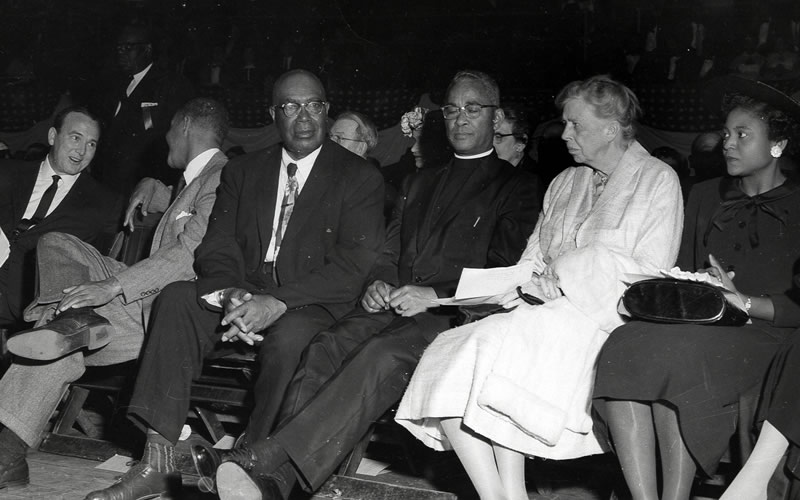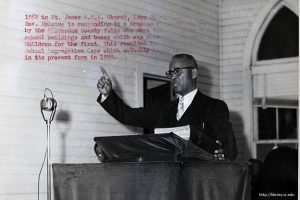
Rev. Joseph A. De Laine Sr., center, sits next to Eleanor Roosevelt (in white) at a New York civil rights rally in 1955. Photo from the University of South Carolina Library’s Digital Collection.
Editor’s Note: Last month in the midst of talk about monuments and statues across the South, South Carolina native Carl Elliott, who these days is a professor in Minnesota, offered a view in The New York Times that our state needed to erect a statue to honor the late Rev. Joseph A. De Laine Sr., a civil rights hero. Here is his commentary, reprinted with his permission. Wouldn’t Charleston be a great home for such a memorial, particularly because the famous Briggs v. Elliott case was heard here?
By Carl Elliott, republished with permission of the author | If you look closely at Brown v. Board of Education, the landmark 1954 school desegregation decision, you’ll see that Brown wasn’t a single case. It was five cases consolidated into one. Briggs v. Elliott, the first of them, took place in my home state, South Carolina. Briggs came about after the Rev. Joseph De Laine organized a group of black parents in Clarendon County to petition for equal educational facilities. The man who stood fast against that request — the Elliott of Briggs v. Elliott — was the chairman of the school board, Roderick Miles Elliott. Or as he was known in my family, Uncle Roddy.
Although I grew up in South Carolina in the 1960s and ’70s, I didn’t learn about Briggs v. Elliott until I was an adult. My father, Uncle Roddy’s nephew, often talked about how shamefully black people were treated in Clarendon County, but he was deeply uncomfortable with the part our family had played. Like most Southerners, he was skilled at avoiding unpleasant conversations, and in the case of Briggs, events conspired to help him. For reasons that remain murky, the Supreme Court case came to be called Brown rather than Briggs, even though Briggs preceded Brown both alphabetically and temporally. So it was Brown v. Board of Education that was memorialized in the history textbooks, and our family name was spared association in the public mind with a racist cause.
I won’t pretend I’m not grateful. But the fact that Brown has overshadowed Briggs has also meant that Mr. De Laine, the man who did more than anyone else to bring about school desegregation in South Carolina, has been too often forgotten. This month, with the blessing of his surviving children, Joseph De Laine Jr. and Ophelia De Laine Gona, my cousin Joe Elliott — Uncle Roddy’s grandson — submitted a letter to the South Carolina legislature on behalf of 21 descendants and relatives of Roderick Miles Elliott (including me), asking the legislature to honor Mr. De Laine with a statue on the grounds of the State House in Columbia.
In a just world, the name of Joseph De Laine would already be familiar to South Carolinians. Mr. De Laine was a minister in the African Methodist Episcopal Church and a teacher in the Clarendon County public schools, where his wife, Mattie, also taught. Black schools in Clarendon County in the 1940s were in abysmal condition — dilapidated, poorly heated and woefully understaffed. Children had to walk miles to attend school, because the school board, led by Uncle Roddy, refused to provide a bus. It provided 30 buses for white children.

You can read more about Rev. De Laine in this excerpt from The South Carolina Encyclopedia.
Mr. De Laine began organizing the parents of Clarendon County in 1947 and kept at it for the next seven years. When the Supreme Court finally vindicated his cause in 1954, it used the dissenting opinion in Briggs as the legal backbone for its decision.
In South Carolina, however, Mr. De Laine’s courage and tenacity were punished. Both he and his wife lost their teaching jobs. When an arsonist set fire to the De Laine home, which stood 60 feet outside the city limits of Summerton, S.C., the all-white firefighting squad in Summerton stood by and watched it burn to the ground. Later, Mr. De Laine’s church in Lake City was burned to the ground as well. He was eventually forced to leave the state in 1955 after defending his home against a group of armed attackers. Mr. De Laine died in Charlotte, N.C, in 1974.
Congress awarded Mr. De Laine a Gold Medal in 2004 (along with the Briggs petitioners Levi Pearson and Harry and Eliza Briggs), but a comparable gesture of recognition has never been made in South Carolina. The state has no monuments to Mr. De Laine, and apart from a small interstate interchange near Summerton, no roads, bridges or public buildings bear his name.
Asking South Carolina to honor Mr. De Laine might seem quixotic. It took decades of protest and the 2015 mass murder at Emanuel A.M.E. Church in Charleston before the Confederate flag came down from the South Carolina State House. Sixty-three years after Brown, schools in Summerton remain de facto segregated, thanks in part to a private academy favored by many white families. Change never comes easily in South Carolina, a state populated by stubborn iconoclasts who can be single-minded in the pursuit of hopeless causes. To which I say: This is exactly why we should honor Mr. De Laine. He showed us how to put that single-mindedness to work for the cause of righteousness.
School desegregation is often seen as a tool for justice, and rightly so. But it is an equally powerful tool for friendship, love and solidarity. Most of my generation of South Carolinians had the privilege of attending the integrated schools that Uncle Roddy fought against. As a result, many of us have formed lasting relationships across racial lines in ways that would have been unimaginable to our Southern grandparents, both black and white. If we can somehow make our way together through these dark times, it will be in no small part because of the vision of Joseph De Laine.
- Carl Elliott is a professor at the Center for Bioethics at the University of Minnesota.
- Have a comment? Send to: editor@charlestoncurrents.com




 We Can Do Better, South Carolina!
We Can Do Better, South Carolina!

























One Comment